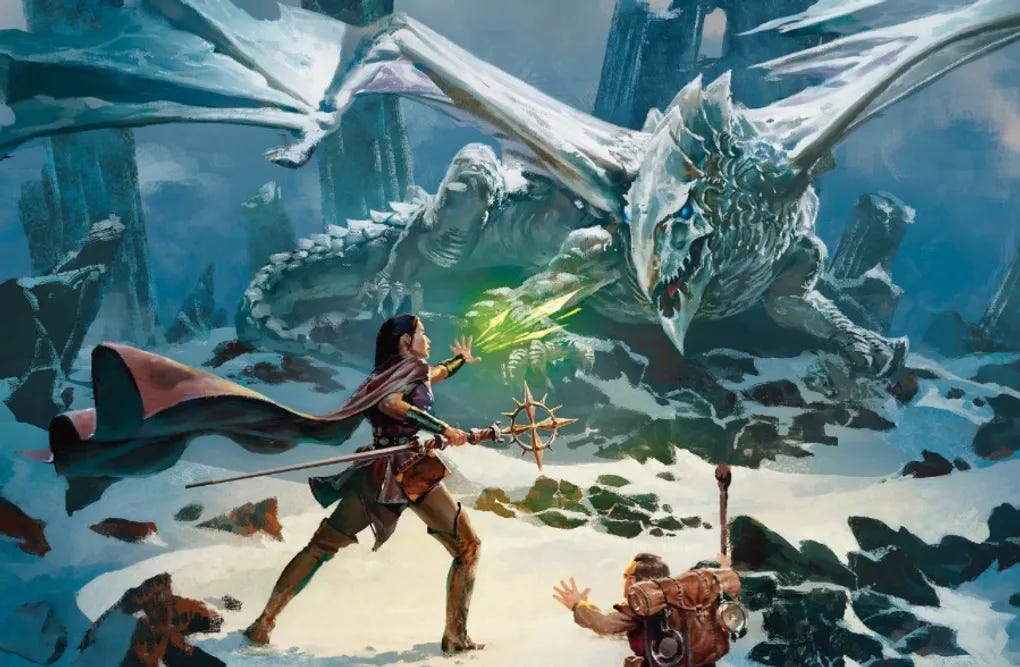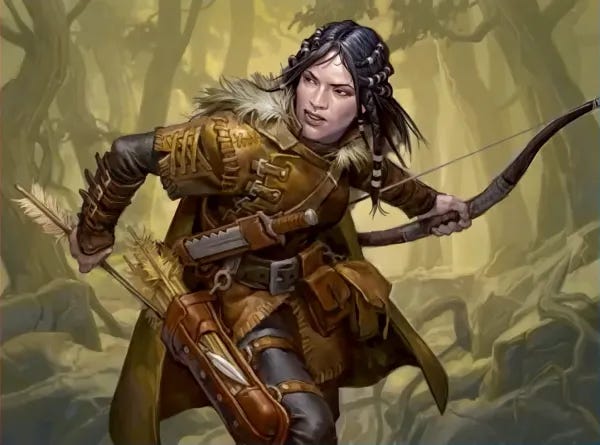Dragon of Icespire Peak: Session Zero

Overview
Dragon of Icespire Peak is an Introductory Adventure for Levels 1-7. It is part of the Essentials Kit from Dungeons and Dragons. The original adventure was included in the box, and the rest was available on dndbeyond as a free add-on (a redeemable code was included in the box).
Travel the lands of the Sword Coast, helping the people you meet and tackling quests until you are strong enough to challenge the dragon that has been terrorizing the countryside!
Session Zero
So, for my first play-through, I wanted to do Dragon of Icespire Peak. I felt it was fitting since it was my first-ever D&D adventure.
Before diving into the play-through, I wanted to lay out some rules I have for myself when I do solo sessions.
Playing with fewer characters
I play with only two characters. And the reason is that it’s far more manageable. From inventory management, species abilities, and class abilities, there’s so much! Even when playing with just one character, you can forget about something. I prefer being invested in the story and the gameplay rather than flipping through pages to remember what something does what.
Balancing
The second rule is about balancing the Adventures. Usually, published adventures are made for four to six players. Because I will play with two, I will divide the number of enemies by half. In some situations, I might adjust the encounter differently. For example, if there’s a boss monster, I might reduce its AC or give it less HP.
Theater of the mind
I will most likely play Theater of the Mind. It is easier to manage, and it is faster to play. But if an encounter seems particularly interesting, I might use a virtual tabletop to play it. If I do, I will most likely use DNDBeyond Maps, since I already have the adventure there as well as the core rules
2024 Rules
Lastly, I will use the 2024 rules. I have been playing with them for a while now, and I really like them. This means I will create my characters using the new Player’s Handbook, and I will use the new Monster Manual as well to replace monsters from Dragon of Icespire Peak with their updated equivalent.
Death
There is only one way for me to stop an adventure: if all my characters die at the same time (TPK). If only one of them dies, I can try to recruit another one by traveling to a nearby settlement. The bigger the settlement is, the bigger the chance of finding one or more characters to recruit. There is usually a gold cost associated with this, but I will cover all the details during the adventure if it happens.
Character Creation
With time, I realize that it was extremely difficult for me to decide what characters I wanted to play, simply because I wanted to play all of them. So I decided to create a system that would help me decide what characters I would play.
Personal Framework
Yes, rolling the dice. This way, I spend much less time thinking about what character I want to play, and more time playing the game. This is what I do for each character:
I roll a 1d12 for the Class
I roll 1d20 for the Background (if 17 or more, I roll again)
I roll 1d10 for the Species
I choose the rest (Skills, Languages, etc.)
Abilities Scores: I use point buy. Playing solo can be a little bit more difficult, so being able to min-max a little bit is nice.
Starting Equipment: I use the starting equipment from the class, and I take the gold amount from the background.
I use a Fantasy Name Generator website to find a proper name related to the species.
I like to find a picture of the characters I play. Sites I like to visit are Pinterest, ArtStation, DeviantArt, and Art of MTG
I write a short description of the character, their personality, backstory, etc. This as two purposes: first, it gives a little bit of depth to the character, and second, it helps for gameplay (roleplaying) reasons. Will these characters be more inclined to look for a secret passage, will they fight to the death, or will it try to negotiate? These are all things that can be useful to know when playing solo because it prevent me from using game information to make decisions that the character would not make.
First Character
Character Overview
Class: Sorcerer (roll 10)
Background: Acolyte (roll 1)
Species: Orc (roll 9)
Proficiencies & Features
Skill Proficiencies: Arcana, Persuasion
Languages: Orc, Goblin
Magic Initiate Spells: Guidance, Light, Healing Word
Ability Scores Bonuses: +2 Charisma, +1 Wisdom
Ability Scores
Strength: 8
Dexterity: 14
Constitution: 14
Intelligence: 8
Wisdom: 13
Charisma: 17
Starting Equipment
Spear, Daggers (2x), Arcane Focus (Crystal), Dungeoneer’s Pack, Gold Pieces 78 (28+50)
Character Description

“Mulush left his tribal home in search of answers he could only find by exploring the lands. His curiosity drives him to investigate every rumor, explore every ruin, and question every stranger he meets. Though his brash demeanor can rub people the wrong way, Mulush genuinely cares for those who aid his journey, viewing them as essential companions in uncovering whatever grand fate awaits him. His acolyte training taught him that divine purpose often comes through service to others.”
Second Character
Character Overview
Class: Ranger (roll 8)
Background: Soldier (roll 15)
Species: Human (roll 8)
Proficiencies & Features
Skill Proficiencies: Nature, Stealth, Survival, Perception (Skillful)
Weapon Mastery: Scimitar (Nick), Shortsword (Vex)
Languages: Elvish, Halfling
Versatile: Tough
Ability Scores Bonuses: +2 Dexterity, +1 Constitution
Ability Scores
Strength: 8
Dexterity: 17
Constitution: 16
Intelligence: 10
Wisdom: 14
Charisma: 8
Starting Equipment
Studded Leather Armor, Scimitar, Shortsword, Longbow, Quiver, Druidic Focus(sprig of mistletoe), Explorer’s Pack, Gold Pieces 57 (7 + 50)
Character Description
“Leia used to be a soldier, but she got tired of following orders and decided to leave that life behind to protect the wilderness and help people who actually need it. She’s pretty stubborn and tends to react first, think later - but her gut instincts are usually spot on. It takes her a long time to warm up to new people. She’s not rude, just cautious.”


